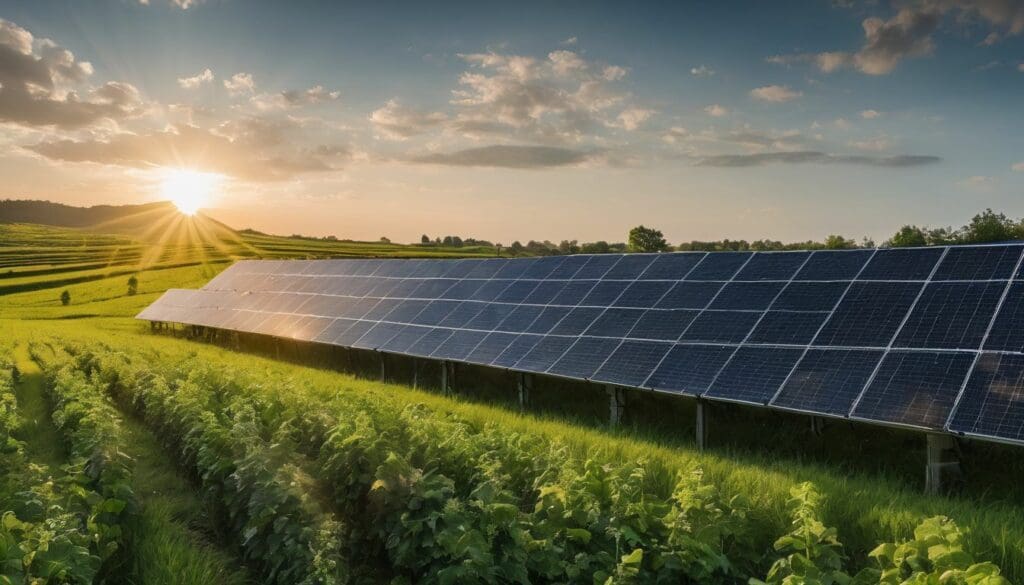We’re all too familiar with the sting of escalating energy costs and the worrisome shifts in our global climate. Many of us have been grappling with these concerns directly, prompting us to delve earnestly into renewable energy solutions that promise a glimmer of hope.
Solar power, which has seen its capacity expand by an average of 20% each year over the last decade, stands out as a particularly bright spot. Our exploration has unearthed some truly ingenious ways to tap into this clean energy source, providing not only relief for our wallets but also a significant reduction in our environmental impact.
So let’s immerse ourselves and emerge with visions of a more sustainable tomorrow!
Key Takeaways
- Renewable energy usage is surging in the United States, with solar and wind power leading growth that’s transforming the nation’s energy outlook.
- Globally, renewables are accelerating at an unmatched pace, indicating a strong shift towards sustainable energy solutions which will shape future economies.
- Various types of renewable energies such as solar, wind, hydroelectric, and geothermal are integral to reducing carbon emissions and promoting environmental sustainability.
- The rise of renewable products contributes to significant job creation across manufacturing, installation, maintenance and research sectors within the clean energy industry.
- Investing in renewable energy is cost – effective in the long run due to lower operational costs compared to traditional fuels while yielding environmental benefits.
Growth of Renewable Energy in the United States
The United States has seen a significant increase in the usage of clean energy, with renewable capacity additions surpassing that of fossil fuels. Predictions for the future show a continued growth and dominance of renewable energy in the country’s energy industry outlook.
Increase in clean energy usage
We’re seeing a significant upswing in clean energy usage across the United States. More homes and businesses are harnessing electricity from solar power than ever before, while wind turbines dot landscapes from coast to coast.
This surge isn’t just about being kind to Earth; it’s also about innovation and pushing boundaries in green technology.
Our commitment to sustainable energy products is reshaping the energy industry outlook. Solar panels have become more efficient and less costly, making them an increasingly popular choice for Americans looking to reduce their carbon footprint.
Renewable power generation through sources like hydroelectricity and bioenergy is gaining momentum as well, promising a cleaner grid with every passing year. As we invest in these renewable resources, we’re not just securing our planet’s future—we’re powering our lives with the very essence of innovation and sustainability.
Predictions for the future
As the demand for clean energy continues to grow, it is predicted that renewable energy products will play an even more significant role in meeting the world’s power needs. Global power capacity from renewable sources is expected to increase substantially, with solar and wind power leading the way in electricity generation.
The continued advancement of renewable energy technologies and increasing investment in this sector are likely to drive further growth in global renewable deployment. Moreover, as countries focus on reducing carbon emissions and increasing energy efficiency, geothermal power and hydropower are also anticipated to make substantial contributions to the new energy economy.
The future of renewable energy looks promising, with widespread adoption leading to a cleaner environment and sustainable economic growth. It’s clear that embracing renewable energy trends will not only benefit our planet but also create job opportunities while offering cost-effective alternatives for electricity generation.
Global Growth of Renewable Energy
Renewable energy is growing at an unprecedented rate worldwide, playing a crucial role in the new energy economy. Its adoption and expansion are accelerating faster than ever before, shaping a more sustainable future for generations to come.
Accelerating faster than ever
Renewable energy is accelerating faster than ever, with global capacity increasing at an unprecedented rate. The shift towards sustainable energy sources has become a driving force in the new energy economy, crucial for combating climate change and reducing our reliance on fossil fuels.
Solar, wind, hydroelectric, and geothermal power are leading the charge as we embrace cleaner and more efficient technologies to power our world.
The importance of renewable energy products cannot be overstated. With advancements in technology and growing awareness of environmental issues, the momentum behind renewable energy continues to build.
Embracing these changes not only benefits the planet but also creates opportunities for job growth and economic development. As we move forward into this exciting era of renewable energy expansion, it’s essential that individuals continue to support conservation efforts and advocate for sustainable practices.
Importance in the new energy economy
Renewable energy plays a crucial role in shaping the new energy economy. With the increasing focus on sustainability and reducing carbon emissions, renewable energy sources like solar, wind, hydroelectric, and geothermal power are becoming essential contributors to our energy mix.
The growth of renewable energy is driving innovation, creating jobs, and promoting environmental conservation. Embracing renewable energy not only reduces our dependence on fossil fuels but also contributes to a more sustainable and cleaner future.
In the new energy economy, global renewable energy capacity is accelerating faster than ever before. This shift towards renewable alternatives offers significant benefits such as lower greenhouse gas emissions and reduced air pollution while providing cost-effective solutions for individuals and businesses alike.
Types of Renewable Energy
Renewable energy comes in various forms such as solar power, wind power, hydroelectric power and geothermal power. Each of these sources offers unique benefits to the environment and the economy.
Solar power
Solar power offers a sustainable and clean energy source, harnessing the sun’s rays to generate electricity. Solar panels capture sunlight and convert it into usable power without producing any greenhouse gas emissions or pollutants.
This renewable energy option is cost-effective in the long run, as it reduces reliance on non-renewable resources while also decreasing electricity bills. Embracing solar power has far-reaching benefits for both individual households and the environment by contributing to a greener, more sustainable future.
Utilising solar energy not only decreases carbon emissions but also creates employment opportunities within the renewable energy industry. The accessibility of solar technology empowers individuals to take charge of their environmental impact while reducing their dependence on traditional grid systems.
Wind power
Moving on from solar power, another key player in the world of renewable energy is wind power. By harnessing the natural force of the wind, we can generate electricity without emitting harmful greenhouse gases.
Wind turbines are an increasingly common sight in many regions, especially those with ample open space and strong winds. These structures convert kinetic energy from the wind into mechanical power, which is then used to produce electricity through a generator.
As a sustainable and clean energy source, wind power continues to play a vital role in reducing our reliance on fossil fuels and mitigating climate change.
The consistent development of wind power technology has led to significant decreases in production costs over recent years, making it one of the most cost-effective forms of renewable energy available today.
Hydroelectric power
Hydroelectric power utilises the force of flowing or falling water to generate electricity. Dams and reservoirs are built to store water, which is then released through turbines to produce energy.
This renewable energy source has significant advantages – it is reliable, efficient, and produces minimal greenhouse gas emissions. Furthermore, hydroelectric power plants can also regulate river flow, preventing floods and providing a consistent supply of water for irrigation.
The use of hydroelectric power contributes significantly to reducing carbon emissions and plays a vital role in promoting sustainable environmental practices.
Geothermal power
Geothermal power harnesses the Earth’s natural heat to produce electricity and provide heating. This renewable energy source is reliable, sustainable, and has minimal environmental impact.
It offers a continuous supply of energy and can be generated around the clock, reducing our reliance on fossil fuels. Geothermal power also contributes to local economies by creating jobs and stimulating economic growth in the areas where geothermal plants are located.
Moreover, geothermal energy supports our transition towards a cleaner environment by reducing greenhouse gas emissions and air pollution. Embracing geothermal power is crucial for promoting conservation efforts and combatting climate change, contributing to a greener future for generations to come.
Impact and Benefits of Renewable Energy
Renewable energy reduces carbon emissions, creates jobs, and is cost-effective. Read on to discover the numerous benefits of switching to renewable energy sources.
Reduced carbon emissions
Renewable energy significantly reduces carbon emissions, helping to combat climate change by decreasing the release of harmful greenhouse gases into the atmosphere. This positive impact on the environment is crucial for sustaining a healthy planet and securing a cleaner, more sustainable future.
Embracing renewable energy products is vital for minimising our carbon footprint and safeguarding the wellbeing of our communities and ecosystems.
By choosing renewable energy sources such as solar power, wind power, hydroelectric power, and geothermal power, we actively contribute to mitigating environmental degradation and prioritising conservation efforts.
Job creation
Renewable energy offers a significant opportunity for job creation, with roles ranging from manufacturing and installation to maintenance and research. As the demand for clean energy continues to grow, more jobs will become available in the renewable energy sector, offering stability and career advancement possibilities.
Investing in renewable energy products not only benefits the environment but also generates employment opportunities, stimulating economic growth while paving the way for a sustainable future.
With an increasing focus on renewable energy initiatives worldwide, job creation in this sector is set to surge, providing individuals with rewarding careers that contribute positively to our planet’s health.
Cost-effectiveness
Renewable energy products offer a cost-effective solution for sustainable power generation. By tapping into natural resources like sunlight, wind, and water, these technologies provide efficient energy production with minimal operational costs.
The long-term benefits of investing in renewable energy outweigh the initial setup expenses. This not only leads to significant savings but also reduces dependency on traditional energy sources, contributing to a greener and more sustainable future.
Additionally, the cost-effectiveness of renewable energy solutions extends beyond monetary considerations. Investing in clean energy technologies creates job opportunities and boosts local economies while reducing harmful emissions that contribute to climate change.
Conclusion
In conclusion, the rise of renewable energy products is transforming our world. Consumers are increasingly embracing clean energy options and making a positive impact on the environment.
Innovations in solar, wind, hydroelectric, and geothermal power are driving this shift towards sustainability. The widespread adoption of renewable energy is creating new opportunities for economic growth and job creation.
With ongoing advancements and increasing support, the future looks bright for renewable energy products.
FAQs
1. What are renewable energy products?
Renewable energy products are items that generate power from sources that naturally replenish, such as solar panels or wind turbines.
2. Why is there a rise in renewable energy products nowadays?
There’s a rise in renewable energy products because they offer cleaner alternatives to fossil fuels and help reduce carbon footprints, making them better for the environment.
3. Can anyone use renewable energy products at home?
Yes, many people can install things like solar panels on their roofs to power their homes with clean energy straight from the sun!
4. Are businesses also using renewable energy products?
Absolutely! Many companies are switching to renewable sources to power their operations, supporting environmental sustainability while sometimes even cutting costs.





